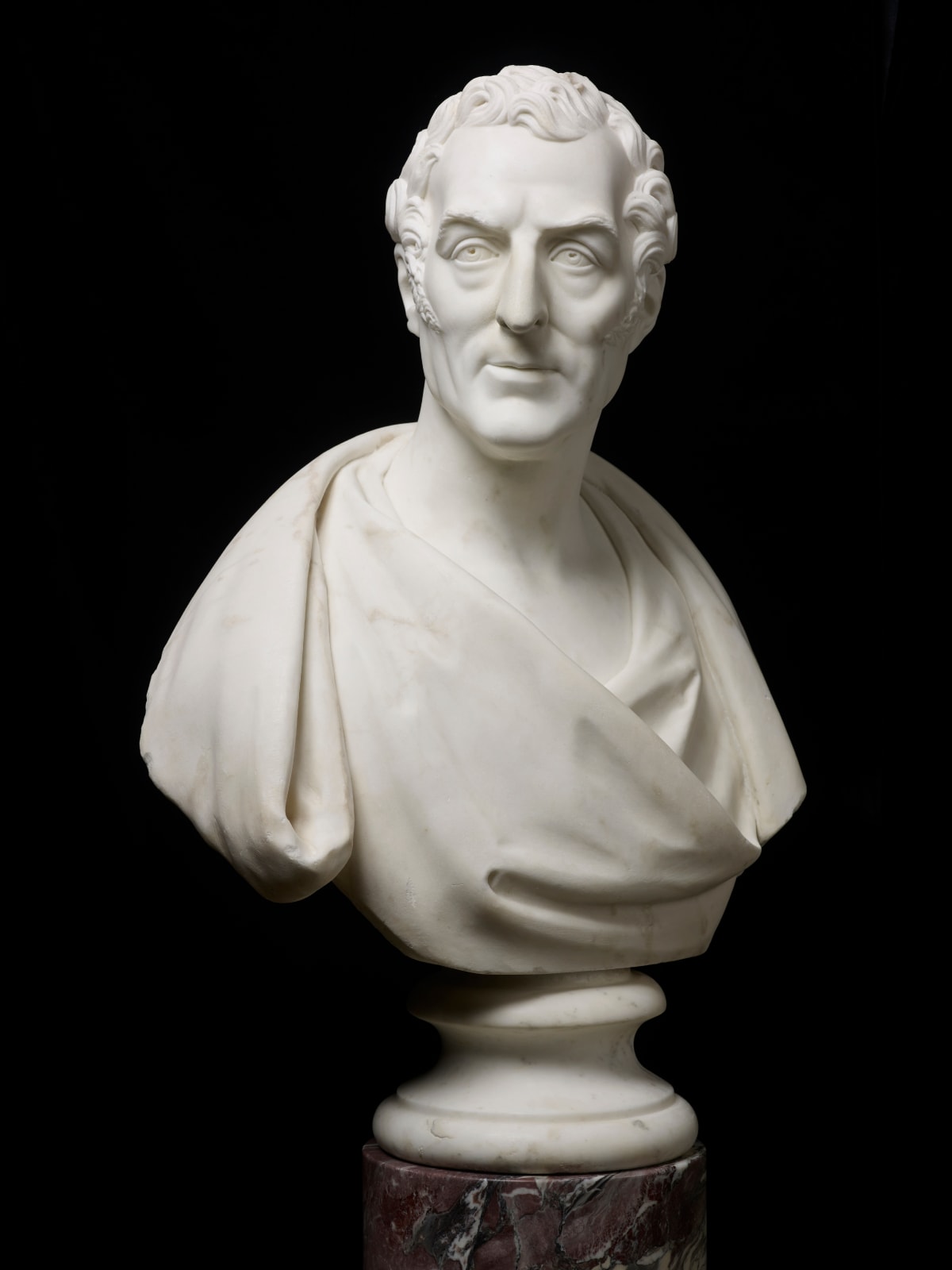
Attributed to Henry Weigall
Arthur Wellesley, 1st Duke of Wellington is regarded as one of the most important and influential military figures in British history, primarily remembered for his victory against Napoleon at the Battle of Waterloo in 1815.
Although this bust type was long attributed to the sculptor Joseph Nollekens based on an erroneously inscribed version in the Government Art Collection, it is now thought to be by Henry Weigall, a spirited sculptor who produced several busts of Wellington and is known to have had sittings with the Duke. There are six examples of this bust type recorded and the best-known version is in the Government Art Collection, currently on loan to the Royal College of Defence Studies, London. Another version in a private English collection is inscribed and dated 1852, which suggests that Weigall returned to this bust type in later life and reproduced on-demand carved likenesses of a younger Wellington.
Although we know Weigall was born in St James’s in 1800, relatively little else is known of his early career other than he was initially a gem engraver and was appointed official engraver to the Duke and Duchess of Cambridge. He was a member of the Royal Society of Arts and exhibited at the Royal Academy between 1837 and 1854 with likenesses of Sir David Davies, Physician in ordinary to the Queen Dowager, author Samuel Warren and Rev. Howlett, Honorary Secretary of Kensington Grammar School. In 1856 Weigall and his wife Selina emigrated to Australia and Weigall died in Melbourne in 1882; his son Henry Weigall Junior went on to become a portrait painter and miniaturist.
Arthur Wesley did not have a promising start in life, losing his father at the tender age of twelve, he was neglected by his mother who considered him uninteresting and not as bright as his elder brothers.[1] He became a socially awkward and unhappy child and was removed from Eton for violent outbursts and his apathetic attitude. Showing little potential, Arthur was placed by his mother in a military school, the Academy of Equitation at Angers, in 1786 where he began to flourish. He commenced his military career in 1787, gaining a commission as an ensign for the 73rd foot, a Highland regiment.
In 1793 Wesley proposed to Lady Catherine Pakenham, an offer that was rejected by her brother who believed Wesley could not support her adequately; this encouraged Wesley in his pursuit of military success, he fought in Flanders in 1794 and directed a campaign in India from 1796. Two years later Arthur Wesley began to sign his name Wellesley. During Wellesley’s time in Seringapatum at the end of the eighteenth century, he was appointed governor and worked on training his men to respect Indian traditions and suppressing gangs of enemy soldiers. One such gang, led by Dhundia Wagh, had hidden his four-year-old son before being killed in battle; Wellesley took it upon himself to look after the child and became responsible for his upbringing.
During Wellesley’s military career, he participated in sixty battles, often leading troops in the defensive style of warfare, and was knighted for his efforts in 1805 when he returned to England. He was made Commander of the British Army during the Peninsular War and was made Duke of Wellington in 1814. His most famous victory, and the last victory of the Napoleonic Wars, was at Waterloo in 1815.
Although Wellington had been involved in politics throughout his adult life, following Waterloo the Prime Minister appointed him Master-General of the Ordnance. Wellington became Prime Minister twice from 1828 until 1830 and then again for less than a month in 1834 and was a leading figure in the House of Lords until his retirement. Wellington died in 1852 and was buried in St Paul’s cathedral after a state funeral.
[1] The family name Wesley was changed in 1789 to the older name Wellesley by the 2nd Earl, Richard Wellesley.
Provenance
Private collection, Oxford.
Be the first to hear about our available artworks
* denotes required fields
We will process the personal data you have supplied in accordance with our privacy policy (available on request). You can unsubscribe or change your preferences at any time by clicking the link in our emails.